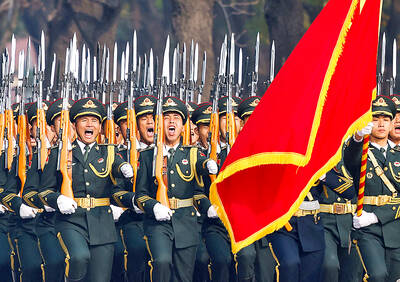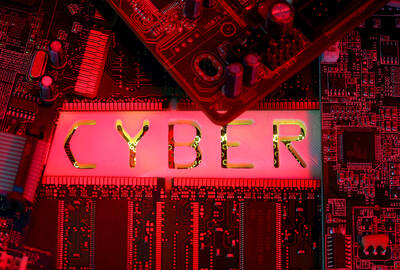Additional deployment of the locally developed Hsiung Feng III (HF-3) “Brave Wind” surface-to-surface supersonic anti-ship missile on LaFayette-class Kang Ding (康定級)and Chi Yang Knox-class(濟陽級) frigates within the year is being considered in the face of China’s increasing buildup of its naval capabilities, the Ministry of National Defense said yesterday.
The HF-3 supersonic surface-to-surface missile had been under research and development by the Chungshan Institute of Science and Technology (中山科學研究院) for nearly two decades, and was made public in a military exercise in 2007.
While the ministry has not released any information on the capabilities of the HF-3 missile, military magazines surmise that the missile may reach speeds of between Mach 2.5 and Mach 3 at a range of between 150km and 200km.

Photo: Taipei Times
The magazines also report that the missile might be equipped with an active radar homing system and would be guided by the navy’s communication and observation systems in a wartime situation, and, as such, the missile could be considered a “fire-and-forget” type of missile.
According to an anonymous source who participated in the Hsiung Feng project, the HF-3 is more precise than either of its predecessors — the Hsiung Feng I and Hsiung Feng II — and is also superior in terms of its ability to penetrate the defensive capabilities of enemy ships.
Commenting on the tight lid the military has kept on the missile’s capabilities and specifications, the source said the difficulty in making supersonic missiles lay not in the principle, but in the missiles’ exterior form and calibrations.
Nations all over the world have classified such information, and Taiwan is no different, the source said.
The source added that the success of the Chungshan Institute in completing the missile was an important milestone for the nation.
The ministry said that the missile has already been deployed on the Cheng Kung-class(成功級) frigate, the navy’s Perry-class frigates, the locally researched and made Ching Chiang class(錦江級), and the Kuang Hua VI-class fast attack missile craft (光華六號).
The ministry is also considering deploying the HF-3 missiles on the two Oliver Hazard Perry-class frigates that the ministry intends to purchase from the US next year, ministry officials said.
Meanwhile, the ministry has professed concern that China also appears interested in researching supersonic surface-to-surface missiles, adding that the success of such a venture was extremely important to the military balance in the Taiwan Strait.

The Ministry of Foreign Affairs (MOFA) yesterday said it is closely monitoring developments in Venezuela, and would continue to cooperate with democratic allies and work together for regional and global security, stability, and prosperity. The remarks came after the US on Saturday launched a series of airstrikes in Venezuela and kidnapped Venezuelan President Nicolas Maduro, who was later flown to New York along with his wife. The pair face US charges related to drug trafficking and alleged cooperation with gangs designated as terrorist organizations. Maduro has denied the allegations. The ministry said that it is closely monitoring the political and economic situation

Conflict with Taiwan could leave China with “massive economic disruption, catastrophic military losses, significant social unrest, and devastating sanctions,” a US think tank said in a report released on Monday. The German Marshall Fund released a report titled If China Attacks Taiwan: The Consequences for China of “Minor Conflict” and “Major War” Scenarios. The report details the “massive” economic, military, social and international costs to China in the event of a minor conflict or major war with Taiwan, estimating that the Chinese People’s Liberation Army (PLA) could sustain losses of more than half of its active-duty ground forces, including 100,000 troops. Understanding Chinese

UNRELENTING: China attempted cyberattacks on Taiwan’s critical infrastructure 2.63 million times per day last year, up from 1.23 million in 2023, the NSB said China’s cyberarmy has long engaged in cyberattacks against Taiwan’s critical infrastructure, employing diverse and evolving tactics, the National Security Bureau (NSB) said yesterday, adding that cyberattacks on critical energy infrastructure last year increased 10-fold compared with the previous year. The NSB yesterday released a report titled Analysis on China’s Cyber Threats to Taiwan’s Critical Infrastructure in 2025, outlining the number of cyberattacks, major tactics and hacker groups. Taiwan’s national intelligence community identified a large number of cybersecurity incidents last year, the bureau said in a statement. China’s cyberarmy last year launched an average of 2.63 million intrusion attempts per day targeting Taiwan’s critical

‘SLICING METHOD’: In the event of a blockade, the China Coast Guard would intercept Taiwanese ships while its navy would seek to deter foreign intervention China’s military drills around Taiwan this week signaled potential strategies to cut the nation off from energy supplies and foreign military assistance, a US think tank report said. The Chinese People’s Liberation Army (PLA) conducted what it called “Justice Mission 2025” exercises from Monday to Tuesday in five maritime zones and airspace around Taiwan, calling them a warning to “Taiwanese independence” forces. In a report released on Wednesday, the Institute for the Study of War said the exercises effectively simulated blocking shipping routes to major port cities, including Kaohsiung, Keelung and Hualien. Taiwan would be highly vulnerable under such a blockade, because it